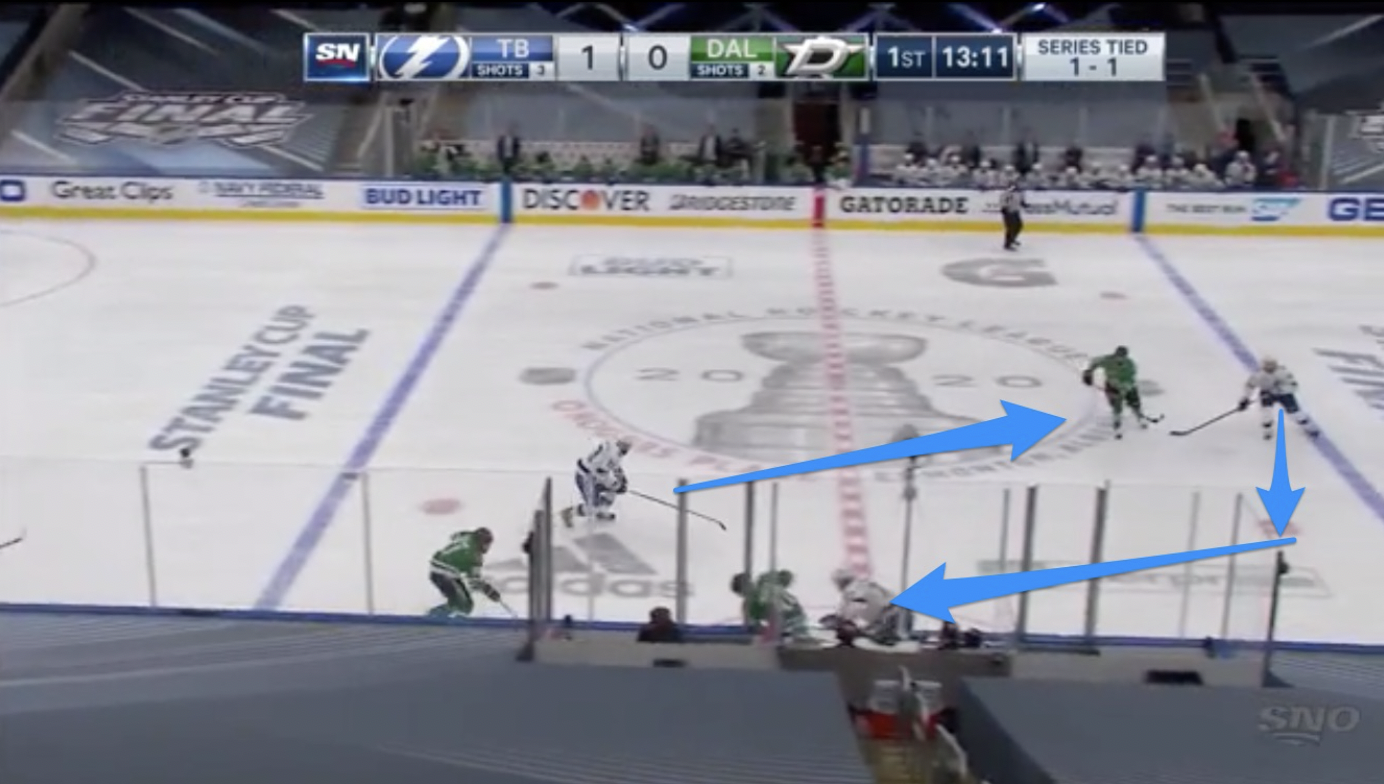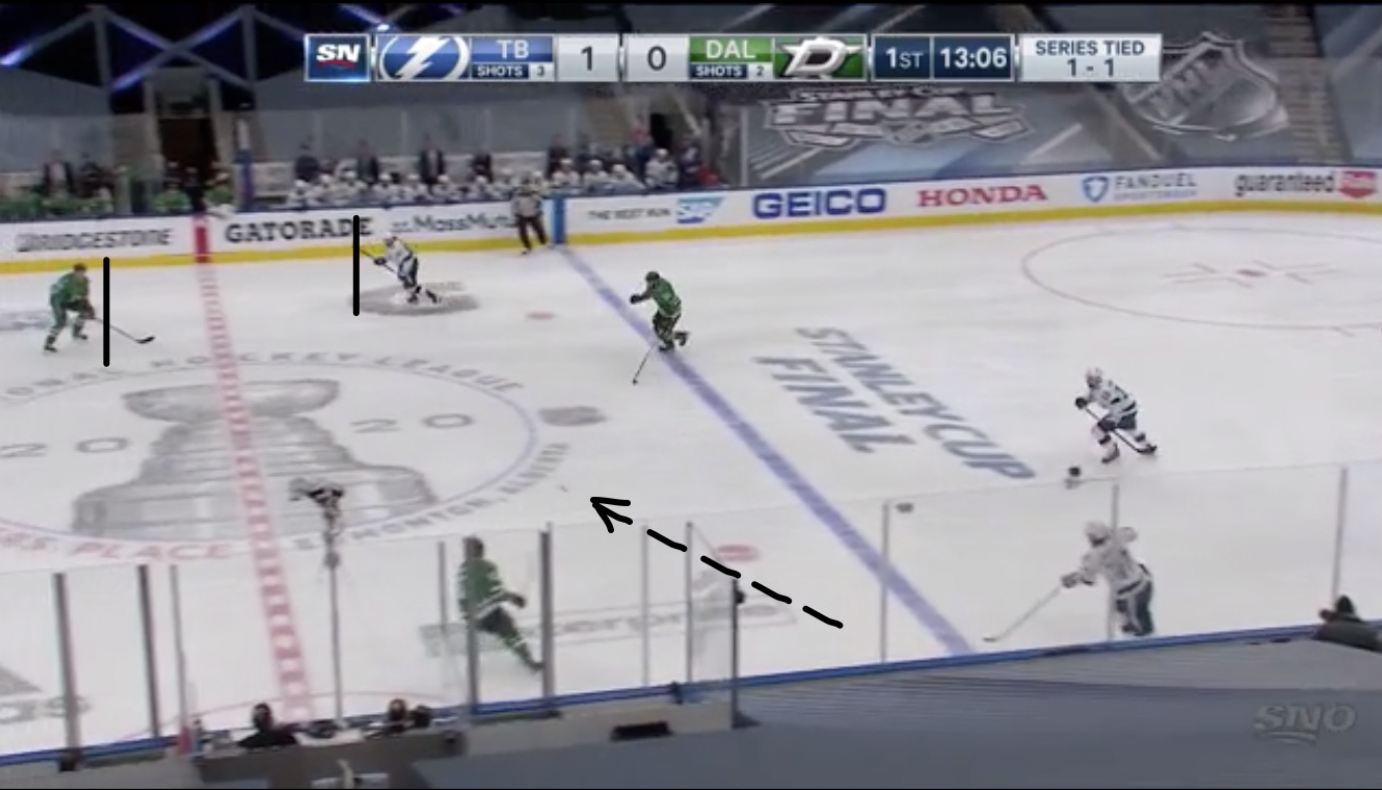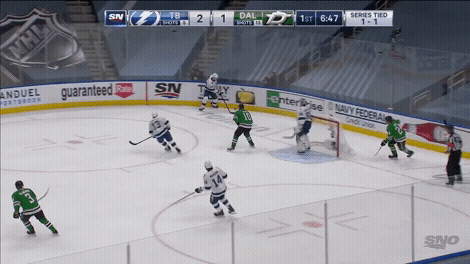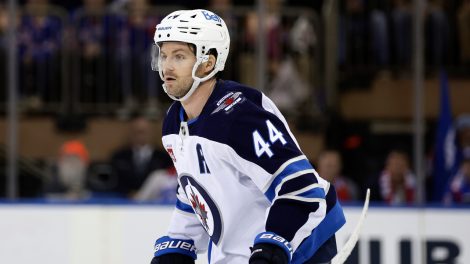With 6:18 remaining in the first period, Steven Stamkos stepped into the Tampa Bay Lightning bench for what has to have been his final seconds of ice time in the 2020 Stanley Cup Playoffs. His first seconds came not long before, with 17:55 to play in the first period. What came in between those two timestamps was summed up by Lightning head coach Jon Cooper thusly:
“He only had five shifts, but probably an efficient five shifts as you’re ever going to see in a National Hockey League playoff game. It was pretty damn cool.”
It was! It was pretty damn cool. And so, given the limited likelihood of Stamkos getting any more ice time, I thought it’d be great to look at the time he did play in some detail for posterity. If the Lightning do win the Cup, the 2:47 he played — which I’ve distilled to about 2:16, because who has that kind of time — will go down in hockey lore. It was as close as hockey can get to giving us a Kirk Gibson moment, and it should be celebrated as such.
I’m expressing skepticism in his return only because of what you’ll see. At no point does he take any significant contact or get pulled in any overly awkward direction, yet he still had to tap out. If his body isn’t ready for the minutes he played — mostly low-stress minutes from a physical standpoint — I’m comfortable saying that’s going to be it, barring some miraculous Game 7 Undertaker moment.
In Game 3, Stamkos had the puck for seven seconds. He made each one of them count.
SHIFT 1
Stamkos starts his 2020 playoffs in dream form, hopping off the bench and getting to mob in on the forecheck. When the puck gets rimmed to the weak side (where he’s headed), Roope Hintz dips low to pick it up. Stamkos gets his ice time started with a nice solid body check, which he follows by backing out to stay above Hintz, falling into Tampa’s neutral zone forecheck.
He’s part of a structure tight enough that they get a turnover and put the puck back in deep on Dallas, where he becomes F2 in another forecheck. What you like here is that he’s doing the boring stuff correctly and not just manically chasing hits with his months-worth of pent-up drive, as evidenced by what comes next.
He curls off that forecheck and becomes the first forward back as Tampa gets the puck in the neutral zone yet again, and puts it quietly into Dallas’ end for a good line change.
He got in a good spot for an outlet, which is unremarkable but still, y’know, good.
Good start all over, wouldn’t you say? He got his feet under him, threw a hit, and his game sweat started.
SHIFT 2
This is clipped a little tight, but Stamkos has just hopped on the ice and immediately gets to a good defensive spot in the neutral zone and gets a takeaway. This is what Cooper partially means by “efficient” I’m sure — Stamkos has barely been on the rink and yet the puck has ended up going the right way every time.
He gets it in deep and forces Dallas to retreat, which allows Tampa to set up its forecheck against set breakouts. These are rare situations where teams run plays at 5-on-5. In the Tampa room, just like Dallas’, there would be a systems reminder sheet for guys to read over with a “SET BO FC.”
It’s actually unbelievably textbook. Watch Patrick Maroon (14) stay above the slasher through the middle, watch Cedric Paquette (13) force a play before the centre red, and of course, watch Stamkos stay above the speed (with “speed” being the guy who just flies up the wall in most set breakouts) in the wide lane. The D step up at the blue line and it’s Tampa’s puck again.
Stamkos heads in on the forecheck as F2 again, but is out of gas, and needs a change.
SHIFT 3
Shift 3. Three. I kinda want to say it like Monica says “seven” on that old episode of Friends, but maybe that’s weird. Pretend I didn’t say that.
To start the shift, Stamkos lines up on his off-side against the wall, so his stick’s to the middle and he can be the shooter on a won draw. They don’t win it though, and since Tampa likes to bring pressure from the middle winger on lost O-zone draws, he pulls back.
And we begin. Have a watch first.
Victor Hedman is getting a lot of love for the pass to Stamkos, but everyone deserves love here. It unfolds in a perfect way, but it unfolds that way because of how the Lightning play it, not by luck.
Hedman pulls back after Dallas wins the draw, but wouldn’t you know it, he has the foresight and confidence to pressure up before the Tampa Bay red, which creates a 50/50 puck instead of Dallas just getting it deep into Tampa’s end. (If he backed off, you’d have never been critical of him — these are things great players do.)
Because Paquette comes all the way back above his guy (the Dallas centre) in the middle of the rink, Jan Ruuta can come over and bat the puck back up the wall to Hedman. So, good on Hedman for the pinch up, good on Paquette for coming back, good on Ruuta for coming across.

If you’ve ever practiced 2-on-2 gap up drills for defencemen, you know how hard this next part is for Esa Lindell because Stamkos gets to come back to his own blue, swing, then attack with speed.
My child drew these lines, I swear.

The thing is, in practice defencemen know what they’re dealing with — a regroup with an oncoming rush — and they know to gap up accordingly. They know what they’re practicing. Here, it’s not yet clear what’s going to happen with the loose puck in the neutral zone, so Lindell is hesitant to run too far up-ice, meaning Stamkos is able to do what’s so hard to do in those practices (and all games): get clear separation from the D.
Here’s the picture of the goal being scored:

I mean not literally, but this is where the goal is scored. If Lindell is gapped up one foot closer to Stamkos it doesn’t happen. (If he’s backed off by another foot it may not either, not that you’d want your D playing that way.)
Stamkos has had time to wind it up, he’s got a head of steam, and he’s one of the … I don’t know, call it five best shooters in the NHL? I think that’s fair.

Everything about this play was built to showcase Stamkos’ strengths as a player, and given the opportunity, man, did those strengths shine.
SHIFT 4
Shift four starts with Stamkos taking the draw because it’s a 4-on-4 situation, but I still don’t love it. Faceoffs require some pulling and activating of the core, and if he was operating this close to the functional/non-functional line, you’d think he’d steer clear of voluntarily entering into those scenarios. I guess hindsight is 20/20, and if a guy says he’s good to go, you use him like he’s good to go.
He loses the draw, but does a good job staying above the Dallas centre (four-on-four is more man-on-man). The push he gives Jamie Benn at the bottom of the Dallas circle there is called a “sting,” which aims to sap the momentum out of a player’s legs before they head up ice. It’s easier to stop momentum from building than it is to slow it once it’s built.
From there not a whole lot happens. Stamkos stays in the right places positionally while his teammates do some good things (get the puck back) and some bad things (turn the puck over), none of which he has any chance to affect. That’s the life of a winger in general. Some nights you’re minus-three doing the same defensive things you did the night you went plus-three.
SHIFT 5 — THE FINAL FRONTIER
On his fifth and final shift, Stamkos is dealt a tough hand. He comes on the ice as the play is moving back towards the Tampa end, and eventually, the play deals him the winger’s toughest task: a rim stuck along the boards under pressure. It’s here, for the first time, I think he looks hesitant.

He makes the right decision in just trying to keep it against the wall and wait for help, but the whole battle looks a little off. He tries to get his body into one of the Dallas players to keep them on the outside of the puck at one point, but it’s got to be here where something starts to feel off for him.
He does eventually get a meaningful touch on the puck, where he tries to tap a little slip to the middle, which ends up being really his only misstep over his 2:47 of ice time. From there, the puck stays in the zone, and he does a fine job keeping the play outside, never getting sucked too far out of position while providing a layer Dallas would have to get through to get to the net.
He’s still skating fine enough as he gets to the bench, but obviously he knows. He gave them all he had to give, provided a big moment and some solid play, and with that, he hangs up his metaphorical skates for the night, and likely the year.
What’s so admirable about what Stamkos did was he demonstrated his commitment to the cause. Not by playing injured, but by putting in the work to get healthy enough to play. It was everything preceding this that gives it its weight. There was no guarantee Tampa would be playing this late in September, but he put in months in the bubble when he didn’t have to. Surely the team would’ve been understanding if he opted out, or if he said “We’ll see if you guys are in it in a month and maybe I’ll join then.”
Stamkos put in tons of rehab hours. He led a team as captain as best he could without being able to play, and when there was a chance he’d be able to, he was willing to take risk walking back that progress for his teammates, for the staff, for the Tampa fans, and for the Stanley Cup. It’s all right here for them now.
I’m willing to bet he’ll forever deem the sacrifices worth it, calling it a “dream come true” in the post-game presser. The time he played may have totalled under three minutes, but that’s three minutes fans of the Lightning may remember for the rest of their lives.
[relatedlinks]







